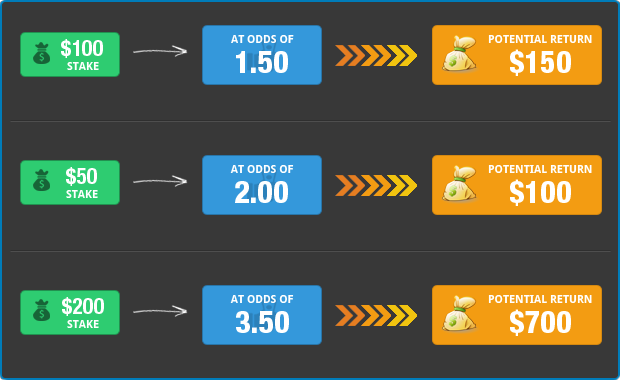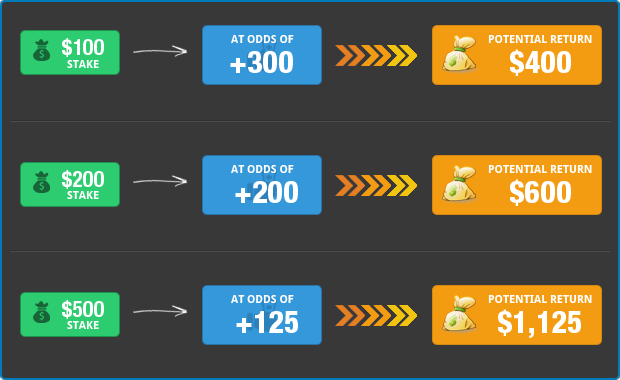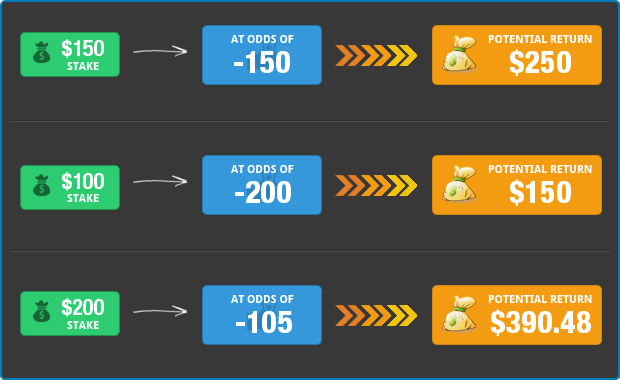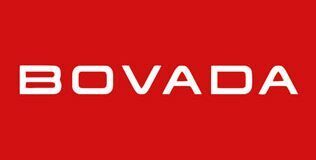Understanding Betting Odds
Odds are an important aspect of sports betting. Understanding them and how to use them is crucial if you want to become a successful sports bettor. Odds are used to calculate how much money you get back from winning wagers, but that’s not all.
What you may not have known is that there are several different ways of expressing odds, or that odds are closely linked to the probability of a wager winning.
They also dictate whether or not any particular wager represents good value or not, and value is something that you should always consider when deciding what bets to place. Odds play an intrinsic role in how bookmakers make money too.
We cover everything you need to know about odds on this page. We urge you to take the time to read through all this information, especially if you are relatively new to sports betting.
However, if you want a visual overview of everything we cover on this page, be sure to view our infographic on the this subject.
The Basics of Odds
As we’ve already stated, odds are used to determine the amounts paid out on winning bets. This is why they are often referred to as the “price” of a wager. A wager can have a price that’s either odds on or odds against.
- Odds On – The potential amount you can win will be less than the amount staked.
- Odds Against – The potential amount you can win will be greater than the amount staked.
You’ll still make a profit from winning an odds on bet, as your initial stake is returned too, but you have to risk an amount that’s higher than you stand to gain. Big favorites are often odds on, as they are more likely to win. When wagers are more likely to lose than win, they will typically be odds against.
Odds can also be even money. A winning even money bet will return exactly the amount staked in profit, plus the original stake. So you basically double your money.

Remember: the higher the odds, the less likely a wager is to win but the greater the rewards will be.
Different Odds Formats
Below are the three main formats used for expressing betting odds.
- Decimal
- Moneyline (or American)
- Fractional
Most likely, you’ll come across all of these formats when playing online. Some sites let you choose your format, but some don’t. This is why knowing all of them is extremely beneficial.
Decimal
This is the format most commonly used by betting sites, with the possible exception of sites that have a predominantly American customer base. This is probably because it is the simplest of the three formats. Decimal odds, which are usually displayed using two decimal places, show exactly how much a winning wager will return per unit staked.
Here are some examples. Remember, the total return includes the initial stake.

The calculation required to work out the potential return when using decimal odds is very simple.
In order to work out the potential profit just subtract one from the odds.
Using the decimal format is as easy as that, which is why most betting sites stick with it. Note that 2.00 is the equivalent of even money. Anything higher than 2.00 is odds against, and anything lower is odds on.
Moneyline/American
Moneyline odds, also known as American odds, are used primarily in the United States. Yes, the United States always has to be different. Surprise, surprise. This format of odds is a little more complicated to understand, but you’ll catch on in no time.
Moneyline odds can be either positive (the relevant number will be preceded by a + sign) or negative (the relevant number will be preceded by a – sign).
Positive moneyline odds show how much profit a winning bet of $100 would make. So if you saw odds of +150 you would know that a $100 wager could win you $150. In addition to that, you’d also get your stake back, for a total return of $250. Here are some more examples, showing the total potential return.

Negative moneyline odds show how much you need to bet to make a $100 profit. So if you saw odds of -120 you would know that a wager of $120 could win you $100. Again you would get your stake back, for a total return of $220. To further clarify this concept, look at these additional examples.

The easiest way to calculate potential returns from moneyline odds is to use the following formula when they are positive.
If you want to know the total potential return, simply add your stake to the result.
For negative moneyline odds, the following formula is required.
Again, simply add your stake to the result for the total potential return.
Note: the equivalent of even money in this format is +100. When a wager is odds against, positive numbers are used. When a wager is odds on, negative numbers are used.
Fractional
Fractional odds are most commonly used in the United Kingdom, where they are used by bookmaking shops and on course bookies at horse racing tracks. This format is slowly being replaced by the decimal format though.
Here are some simple examples of fractional odds.
- 2/1 (which is said to as two to one)
- 10/1 (ten to one)
- 10/1 (ten to one)
And now some slightly more complicated examples.
- 7/4 (seven to four)
- 5/2 (five to two)
- 15/8 (fifteen to eight)
These examples are all odds against. The following are some examples of odds on.
- 1/2 (two to one on)
- 10/11 (eleven to ten on)
- 4/6 (six to four on)
Note that even money is technically expressed as 1/1, but is typically referred to simply as “evens.”
Working out returns can be overwhelming at first, but don’t worry. You WILL master this process with enough practice. Each fraction shows how much profit you stand to make on a winning wager, but it’s up to you to add in your initial stake.
The following calculation is used, where “a” is the first number in the fraction and “b” is the second.
Some people prefer to convert fractional odds into decimal odds before calculating payouts. To do this you just divide the first number by the second number and add one. So 5/2 in decimal odds would be 3.5,6/1 would be 7.0 and so on.
Odds, Probability & Implied Probability
To make money out of sports betting, you really have to recognize the difference between odds and probability. Although the two are fundamentally linked, odds aren’t necessarily a direct reflection of the chances of something happening or not happening.
Probability in sports betting is subjective, plain and simple. Both bettors and bookmakers alike are going to have a difference of opinion when it comes to predicting the likely outcome of a game.
Probabilities typically vary by 5% to 10%: sometimes less, sometimes more. Successful sports betting is largely about making accurate assessments about the probability of an outcome, and then determining if the odds of that outcome make a wager worthwhile.
To make that determination, we need to understand implied probability.
A great rule of thumb to live by is this; only ever place a wager when there’s value. Value exists whenever the odds are set higher than you think they should be. Implied probability tells us whether or not this is the case.
To explain implied probability more clearly, let’s look at this hypothetical tennis match. Imagine there’s a match between two players of an identical standard. A bookmaker gives both players the exact same chance of winning, and so prices the odds at 2.00 (in decimal format) for each player.
In practice a bookmaker would never set the odds at 2.00 on both players, for reasons we explain a little later. For the sake of this example, though, we will assume this is what they did.
What these odds are telling us is that the match is essentially the same as a coin flip. There are two possible outcomes and each one is just as likely as the other. In theory, each player has a 50% chance of winning the match.
This 50% is the implied probability. It’s easy to work out in such a simple example as this one but that’s not always the case. Luckily, there’s a formula for converting decimal odds into implied probability.
This will give you a number of between zero and one, which is how probability should be expressed. It’s easier to think of probability as a percentage though, and this can be calculated by multiplying the result of the above formula by 100.
The odds in our tennis match example are 2.00 as we’ve already stated. So 1 / 2.00 is .50, which multiplied by 100 gives us 50%.
If each player truly did have a 50% chance of winning this match, then there would be no point in placing a wager on either one. You’ve got a 50% chance of doubling your money, and a 50% chance of losing your stake. Your expectation is neutral.
However, you might think that one player is more likely to win. Perhaps you have been following their form closely, and you believe that one of the players actually has a 60% chance of beating his opponent.
In this case, value would exist when betting on your preferred player. If your opinion is accurate, you’ve got a 60% chance of doubling your money and only a 40% chance of losing your stake. Your expectation is now positive.
We’ve really simplified things here, as the purpose of this page is just to explain all the ways in which odds are relevant when betting on sports. We’ve written another article which explains implied probability and value in much more detail.
For now, you should just understand that odds can tell us the implied probability of a particular outcome happening. If our view is that the actual probability is higher than the implied probability, then we’ve found some value.
Finding value is a key skill in sports betting, and one that you should try to master if you want to be successful.
Balanced Books & The Overround
How do bookmakers make money? It is simple really; they try to take more money in losing wagers than they pay out in winning wagers. In reality, though, it isn’t quite that simple.
If they offered completely fair odds on an event then they would not be guaranteed a profit and would be potentially exposed to risk. Bookmakers do NOT expose themselves to risk. Their goal is to make a profit on every event they take bets on. This is where a balanced book and the overround come in play.
As we mentioned in the betting example above, in practice you wouldn’t actually see two equally likely outcomes both priced at 2.00 by a bookmaker. Although this would technically represent fair odds, this is NOT how bookmakers operate.
For every event that they take bets on, a bookmaker will always look to build in an overround. They’ll also try to ensure that they have balanced books.
Of course, a bookmaker wouldn’t make any money in the above scenario. They have taken a total of $20,000 in wagers and paid the same amount out. Their goal is to be in a situation where they pay out less than they take in.
This is why, in addition to having a balanced book, they also build in the overround.
The overround is also known as vig, or juice, or margin. It’s effectively a commission that bookmakers charge their customers every time they place a wager. They don’t directly charge a fee though; they just reduce the odds from their true probability. So the odds that you would see on a tennis match where both players were equally likely to win would be about 1.91 on each player.
If you again assumed that they took $10,000 on each player, then they would now be guaranteed a profit whichever player wins. Their total pay-out would be $19,100 in winning wagers against the total of $20,000 they have taken. The $900 difference is the overround, which is usually expressed as a percentage of the total book.
This above scenario is an ideal situation for my bookmaker. The volume of bets a bookmaker takes in is so important to them, because their goal is to make money. The more money they take, the more likely they are to be able to create a balanced book.
The overround and the need for a balanced book is also why you will often see the odds for sports events changing. If a bookmaker is taking too much money on a particular outcome, they will probably reduce the odds to discourage any further action.
Also, they might increase the odds on the other possible outcome, or outcomes, to encourage action against the outcome they have already taken too many wagers on.
Be aware; bookmakers are not always successful in creating a balanced book, and they do sometimes lose money on an event. In fact, bookmakers losing money on an event isn’t uncommon by any means, BUT they do generally get close to being balanced far more often than not.
Remember though, just because the bookmakers make sure they turn a profit in the long run doesn’t mean you can’t beat them. You don’t have to make them lose money overall, you just have to concentrate on making more money from your winning wagers than you lose on your losing wagers.
This may sound complicated, but it isn’t. As long as you have a basic understanding of how bookmakers use overrounds and balanced books and as long as you have a general understanding of how odds are used in betting, then you have what you need to be successful.
Below is our infographic that gives a complete visual summary of everything that we’ve covered on this page. Be sure to check it out and feel free to use the embed feature available below.
 75%
75% 80%
80%

